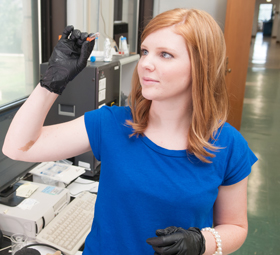August 27, 2012
Super glue: Tests show that adhesive could improve safety of LASIK eye surgery
Submitted by Communications and Marketing

Kansas State University researchers have developed a glue mixture that may reduce risks after laser vision correction surgery.
Stacy Littlechild, a recent bachelor's degree graduate in biology originally from Wakeeney, is the lead author of two studies that describe a new protocol involving fibrinogen, riboflavin and ultraviolet light that could improve the safety of the corrective surgery.
One study that demonstrates the ability of a glue to bind corneal surfaces has been published in the June edition of the journal Investigative Ophthalmology & Visual Science, or IOVS. Another study details the molecular mechanisms of how the glue creates adhesion and also will be published in IOVS.
LASIK, or laser-assisted in-situ keratomileusis, surgery uses a laser to reshape the cornea, the eye's outer layer that helps the eye focus. Many patients have the surgery so they do not have to depend on glasses or contact lenses.
During the procedure, a flap is cut in the cornea so that a laser can remove corneal tissue. The hinged flap is returned to its original position and is held on to the laser-modified cornea with nothing but surface tension.
The cornea has a limited ability to firmly re-adhere the LASIK flap and does not fully heal after the procedure, said Gary Conrad, university distinguished professor in the Division of Biology. Conrad, the principal investigator of the research, studies eye development and was Littlechild's adviser.
"Although LASIK produces a flap that remains clear and normally lays smoothly on the modified corneal surface, if the eye is hit with blunt force trauma -- from an auto airbag or a tennis ball, for example -- the flap simply peels open again, resulting in contamination inside the cornea and requiring immediate medical attention, which can include corneal transplantation," he said.
Cornea transplantation replaces part of the cornea with cornea tissue from a donor and is the most common type of organ transplantation in the U.S. Rejection occurs in about 20 percent of cornea transplants, according to the Mayo Clinic.
"Although a cornea transplant is a routine outpatient procedure, we need to do everything we can to avoid such a transplant," Littlechild said. "These patients are in pain, out of work and can't see for a few days afterward. If we can decrease the need for transplants by using a glue, then we won't impede lives as much and protect patients from having future surgeries."
In the first study, Littlechild tested the glue using corneas removed from dogfish sharks and rabbits to measure adhesive strength.
She discovered that using glue made from fibrinogen and riboflavin and then binding proteins and glue together using ultraviolet light -- the type used in tanning salons -- provided the best adhesion to keep the cornea's flap in place. The substance is a nontoxic biodegradable glue that is used in cataract surgery and does not leave a cloudy scar.
"The idea is that if you use the glue, you'll either reduce or alleviate the risk associated with LASIK surgery," Littlechild said. "The hope is that you would never have to worry about needing a transplant later."
In a second study, Littlechild analyzed specific molecular interactions that are responsible for the adhesion. She found that both covalent and zinc-mediated non-covalent mechanisms contributed to the adhesion.
The finding could prompt further development of the glue and could reveal alternative uses throughout the body, Littlechild said. The glue has the potential to bond other body tissues that are similar in chemical and molecular composition to the cornea.
For instance, tendon tissue that connects muscle to bone is similar to the cornea. Tendon tissue often heals slowly because it does not have many blood vessels; likewise, the cornea does not have any blood vessels.
Other collaborators in the research include Gage Brummer, a senior in biochemistry and premedicine, Prairie Village; John Tomich, professor of biochemistry; and Yuntao Zhang, research assistant professor of biology. Scott McCall, a May 2010 bachelor's graduate in biochemistry, was the lead author on a related study detailing the effects of riboflavin and ultraviolet light used for strengthening the cornea connective tissue to treat keratoconus, the second-most frequent symptom requiring corneal transplantation.
Research funding came from the Maine IDeA Network for Biomedical Research Excellence in support of work at the Mount Desert Island Biological Laboratory in Salisbury Cove, Maine; the Kansas State University Johnson Cancer Research Center; Kansas IDeA Network for Biomedical Research Excellence; National Center for Research Resources; and the National Eye Institute of the National Institutes of Health.
Littlechild plans to attend Cardiff University in Wales, Great Britain, to earn a doctorate in biophysics. Littlechild presented posters at two annual ophthalmology meetings that led to the invitation to continue her research at Cardiff.
"I would not be where I am today without Kansas State University and Dr. Conrad's continued support and patience," said Littlechild, who originally applied for a student office job in the Division of Biology until she received a phone call from Conrad. "I owe my undergraduate success and everything that develops from it to Dr. Conrad's unfailing efforts."
